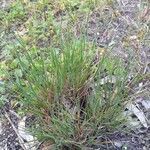Very densely tufted perennial 250-650 mm high; mature plant droops. Leaf blade 150-450 x 0.25-0.50 mm, setaceous: ligule obtuse. Inflorescence open, sparsely branched. Spikelet 6.0-8.5 mm long (excluding awns); glumes ± equal, long finely acuminate, purple; lemma obovate, asymmetrical, widest near apex, strongly overlapping, narrowing abruptly to crown; crown not obvious, straightsided; rim not obvious, either lacerate or entire, glabrous, coarsely tuberculate, hairy basally; awn 15-35 mm long, off centre, straight or geniculate, lower part scabrid or very short hairy, rest scabrid; callus acute, long hairy; anthers 1.0-1.5 mm long.
Very densely tufted perennial, 250-650 mm high. Leaf blade 150-450 x 0.250.50 mm, setaceous; ligule an unfringed membrane. Inflorescence a panicle; spikelets all alike, pedicelled. Spikelets 6.0-8.5 mm long (excluding awns), laterally compressed; glumes ± equal, longer than spikelet, similar, rounded on back, 3-nerved, swollen around floret at base, long, finely acuminate. Floret 1; lemma firmer than glumes, becoming indurated, tuberculate, rough, strongly overlapping; awn up to 35 mm long, asymmetrically attached, geniculate, robust, longer than body of lemma. Flowering time Aug.-Jan.
Plants dense, to 0.7 m tall. Leaves: ligule 0.5–2.5 mm long, obtuse or truncate, papery; blade convolute-filiform, 0.25–0.5 mm wide, very bristly. Inflorescence at length shortly exserted, 10–25 cm long, pyramidal, effuse, often purplish, with rather few spikelets towards tips of ultimate branches, detaching at maturity. Glumes acuminate; lower glume 6–8.5 mm long; upper glume 5–7.5 mm long. Callus
Densely tufted perennial to 60 cm. Leaves linear, rolled, tough. Spikelets 6.0-8.5 mm long, in an open panicle, awns slender, 35 mm long.

